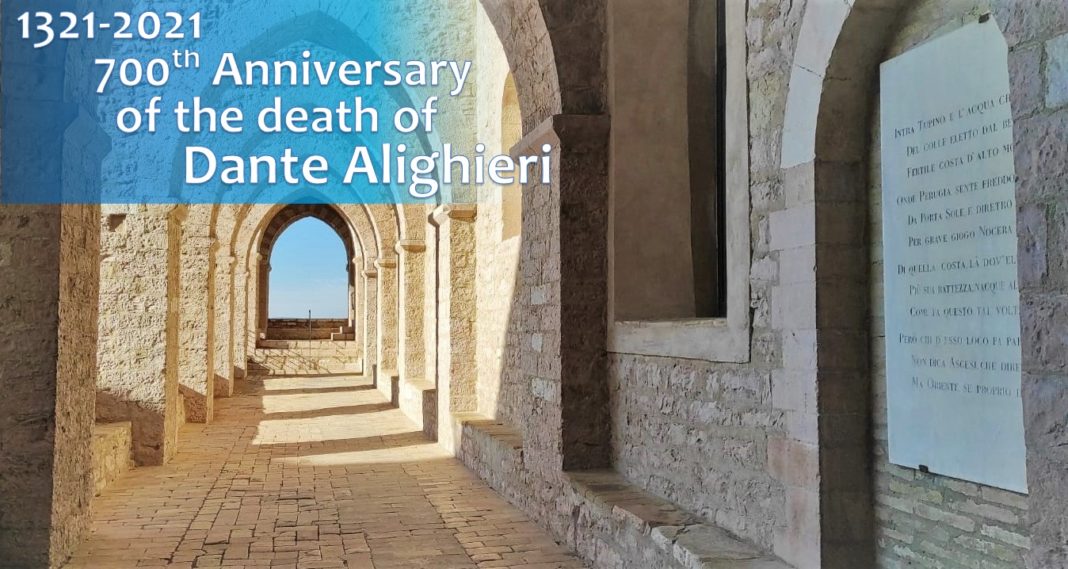INTRODUCTION
The portico of the Sacred Convent of Assisi overlooks Perugia and the entire Valley of Spoleto. It is a place so dear to us friars that it feels like home. There is a plaque mounted there, inscribed with the following stanzas:
Between Topino’s stream and that which flows
down from the hill the blessed Ubaldo chose,
from a high peak there hangs a fertile slope;
from there Perugia feels both heat and cold
at Porta Sole, while behind it sorrow
Nocera and Gualdo under their hard yoke.
From this hillside, where it abates its rise,
a sun was born into the world, much like
this sun when it is climbing from the Ganges
Therefore let him who names this site not say
Ascesi, which would be to say too little,
but Orient, if he would name it rightly.
There is no telling how many times those words have been seen by people who have had the good fortune to come and go there. They are verses 43-54 from Canto XI of Dante’s Paradiso [Heaven], the third cantica of what tradition calls the Divine Comedy, because it contains—as the author himself declares—“this work so shared by heaven and by earth” (Par. XXV 2). Canto XI is entirely dedicated to the Poverello, whose praises are sung by St. Thomas Aquinas. Whereas, in the next canto, our St. Bonaventure sings the praises of St. Dominic, the spiritual father of Aquinas. Both author and protagonist, Dante Alighieri is considered the father of the Italian language and Christianity’s greatest poet. This year marks the 700th anniversary of his death. A commemorative program was launched on September 4, 2020, in Ravenna, Italy, the city where Dante completed his poem, as well as his life, and the place where he was buried.
In a series of articles to come, we will be focusing on various aspects of the life and work of this character. He was a man whose fortunes went beyond the borders of his own homeland, the place he called, “that fair land where sì is heard” (Inf. XXXIII 80). We will also take a little pride in talking about Dante’s relationship with St. Francis and with the Franciscans of his day. In addition, we will discuss how Franciscans over the centuries have been drawn to Dante and his poem.
We invite you, and ourselves as well, to let this series inspire you to read or reread the Divine Comedy, perhaps from the beginning or starting up with one of the better known cantos. This should not be too difficult for anyone because the work is widely distributed and has been translated into several European, South American, Asian and African languages.
We are sure you will find it pleasant reading, and even more, a useful guide for your daily journey from “the little patch of earth that makes us here so fierce” (Par. XXII 151) to the goal that everyone desires and dreams of, “the Love that moves the sun and all the other stars “(Par. XXXIII 145).
To the praise of Jesus Christ and of his servant Francis…
and to the honor of Dante Alighieri, “our” poet!
The friars of the Dante Center of Ravenna
Sequence of articles:
| Introduction | |
| I. | The reasons for celebrating a Centenary |
| II. | The person |
| III. | The work |
| IV. | The Divine Comedy
|
| V. | Dante, St. Francis and the Franciscans |
| VI. | The Franciscans and Dante
|

I
THE REASONS FOR CELEBRATING A CENTENARY
On September 4, 2020, with the President of the Italian Republic, Sergio Mattarella, attending, the seventh centenary of Dante Alighieri’s death was launched in Ravenna, Italy. Dante’s death took place in that city between September 13 and 14, 1321, “on the day” as Giovanni Boccaccio wrote in his Trattatello in laude di Dante, “that the exaltation of the Holy Cross is celebrated by the Church” (XIV). Boccaccio himself remembers that the body of the great poet was brought “to the place of the Friars Minor,” (XV) the Church of San Pietro Maggiore, popularly called then, as today, the Church of San Francesco. Dante’s funeral was celebrated there and finally, his body was buried in the adjacent cemetery.
This anniversary can be an occasion—as Pope Francis hopes—to “make the figure of Alighieri and his work understood and appreciated again, to accompany us on our personal and community journey. In fact, the Comedy can be read as a great itinerary, rather as a true pilgrimage, both personal and interior, as well as communal, ecclesial, social and historic. It represents the paradigm of every authentic voyage in which humanity is called to leave behind what Dante calls ‘the little patch of earth that makes us here so fierce’ (Par. XXII, 151) in order to reach a new condition, marked by harmony, peace and happiness”[1]. Moreover, this is not the first time that a Pontiff has pointed to the figure and work of the great poet.

In the last century—and we will stop there—Benedict XV did the same on Dante’s centenary in 1921. He affirmed that the particular reason why the Church, too, should celebrate that “solemn anniversary with grateful memory and great crowds of people” lay in the fact that “Alighieri is ours”[2]. Moreover, the Pontiff himself dedicated an encyclical to Dante in 1921, which concluded as follows: “Heaven grant that this may be the fruit of the Dante Centenary: that wherever literary instruction is given, the great poet may be held in due honor and that he himself may be for the pupils, the teacher of Christian doctrine, he whose one purpose in his poem was ‘to raise mortals from the state of misery,’ that is from the state of sin, ‘and lead them to the state of happiness,’ that is of divine grace” (Dante Alighieri Epistle XIII, 15)[3].

The same idea was then taken up by St. Pope Paul VI, who in 1965, for the seventh centenary of the birth of the one he defined as “the lord of the highest song” wrote: “Perhaps some would want to ask why the Catholic Church wishes, by its visible Head, to take to heart cultivating the memory and celebrating the glory of the Florentine Poet. Our response is easy: by direct claim—Dante is ours! Ours, by which we mean to say, of the Catholic Faith; ours, because breathing the love of Christ he very much loved the Church and sang Her glories; and ours, because he acknowledged and venerated in the Roman Pontiff the Vicar of Christ on earth.” Certainly, the Pontiff did not remain silent at the time about the fact that the Poet’s voice “lashed out severely against more than one Roman Pontiff, and had harsh reproofs for ecclesiastical institutions and for persons who were representatives and ministers of the Church.” However, he recognized that this criticism never shook “his firm Catholic faith and his filial affection for Holy Mother Church”[4].
This “ours,” then, is someone who challenges us as children of that Mother and as Franciscans, too. If it is uncertain—as a particular tradition claims—that Dante was ever really a Franciscan tertiary or even a novice of the Order, what is certain is that he loved our father St. Francis—the only person to whom Dante dedicated an entire canto of his Divine Comedy. Moreover, he also loved the Franciscan family, and for precisely that reason, he did not spare them his harsh reproaches for having distanced themselves from the evangelical ideal of the Poverello. Therefore, we too can say that “Dante is ours,” and we affirm this—as Paul VI invited us to do in his aforementioned apostolic letter—not out of egoistic pretense, but rather so that we assume the responsibility of listening to his voice and making it resound again, convinced, along with St. Pope John Paul II, that his “art evokes lofty emotions and the greatest convictions, and still proves capable of instilling courage and hope, guiding contemporary man’s difficult existential quest for the Truth which knows no setting.”

On October 10, 2020, Pope Francis received the Ravenna delegation at the Vatican carrying the golden cross that Saint Paul VI had donated for the blessing of Dante’s tomb. At the end of the tomb’s recent restorations, that cross “such a sign of religion and hope” was put back where it had been originally mounted on September 19, 1965, when thirty-five Franciscan archbishops and bishops, participating in the Second Vatican Council, looked on. On that occasion, the Pontiff announced his intention to offer during the centenary year—in continuity with his predecessors—a more extensive, and by then, imminent reflection on “our” Dante.
[1] Messaggio al Presidente del Pontificio Consiglio della Cultura in occasione delle celebrazioni del 750° anniversario della nascita di Dante Alighieri, May 4, 2015: published online at: http://www.vatican.va/content/francesco/it/messages/pont-messages/2015/documents/papa-francesco_20150504_messaggio-dante-alighieri.html (French, English, Portuguese, Spanish and German versions are published on the same website at www.vatican.va).
[2] Epistola Nobis, ad catholicam al Reverendo Padre Don Pasquale Morganti, arcivescovo dei ravennati e vescovo dei cervesi, in occasione del VI centenario della morte di Dante Alighieri, October 28, 1914, published online at: http://www.vatican.va/content/benedict-xv/it/letters/1914/documents/hf_ben-xv_let_19141028_nobis-ad-catholicam.html
[3] Lettera enciclica In praeclara summorum in occasione del VI Centenario della morte di Dante Alighieri, April 30, 1921. The Italian version is published online at: http://www.vatican.va/content/benedict-xv/it/encyclicals/documents/hf_ben-xv_enc_30041921_in-praeclara-summorum.html (French and English versions are published on the same website at www.vatican.va).
[4] Litterae apostolicae motu proprio datae: ltissimi cantus septimo exeuente saeculo a Dantis Aligherii ortu, December 7, 1965; published online at: http://www.vatican.va/content/paul-vi/la/motu_proprio/documents/hf_p-vi_motu-proprio_19651207_altissimi-cantus.html. An Italian version (unofficial) is published online at: http://www.gliscritti.it/approf/sacchi/paolo6.htm. An English version (unofficial) is published online at: https://d2y1pz2y630308.cloudfront.net/2287/documents/2016/12/PPaulVIMotuPro2.htm














